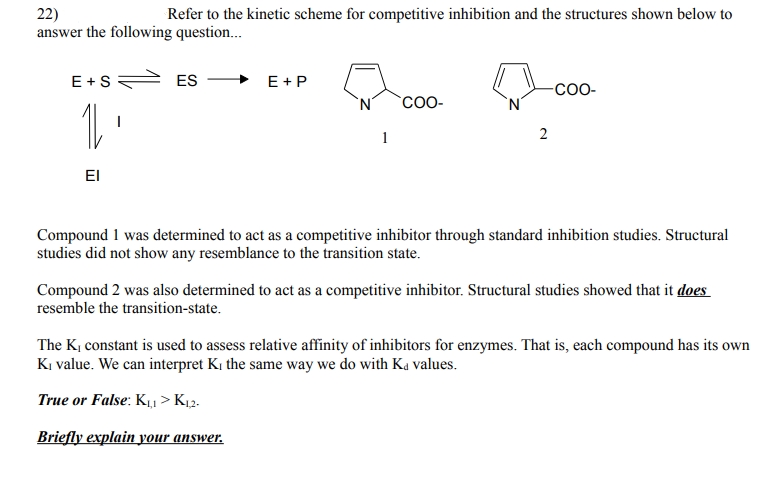22) answer the following question. Refer to the kinetic scheme for competitive inhibition and the structures shown below to E+S ES + E+P -CO- `co- 1 2 EI Compound 1 was determined to act as a competitive inhibitor through standard inhibition studies. Structural studies did not show any resemblance to the transition state. Compound 2 was also determined to act as a competitive inhibitor. Structural studies showed that it does resemble the transition-state.
22) answer the following question. Refer to the kinetic scheme for competitive inhibition and the structures shown below to E+S ES + E+P -CO- `co- 1 2 EI Compound 1 was determined to act as a competitive inhibitor through standard inhibition studies. Structural studies did not show any resemblance to the transition state. Compound 2 was also determined to act as a competitive inhibitor. Structural studies showed that it does resemble the transition-state.
Biochemistry
9th Edition
ISBN:9781319114671
Author:Lubert Stryer, Jeremy M. Berg, John L. Tymoczko, Gregory J. Gatto Jr.
Publisher:Lubert Stryer, Jeremy M. Berg, John L. Tymoczko, Gregory J. Gatto Jr.
Chapter1: Biochemistry: An Evolving Science
Section: Chapter Questions
Problem 1P
Related questions
Question
100%

Transcribed Image Text:22)
answer the following question..
Refer to the kinetic scheme for competitive inhibition and the structures shown below to
E+S
ES
E +P
-co-
CO-
1
2
EI
Compound 1 was determined to act as a competitive inhibitor through standard inhibition studies. Structural
studies did not show any resemblance to the transition state.
Compound 2 was also determined to act as a competitive inhibitor. Structural studies showed that it does
resemble the transition-state.
The K, constant is used to assess relative affinity of inhibitors for enzymes. That is, each compound has its own
K, value. We can interpret K, the same way we do with Ka values.
True or False: K, > Kµ2.
Briefly explain your answer.
Expert Solution
This question has been solved!
Explore an expertly crafted, step-by-step solution for a thorough understanding of key concepts.
Step by step
Solved in 2 steps

Knowledge Booster
Learn more about
Need a deep-dive on the concept behind this application? Look no further. Learn more about this topic, biochemistry and related others by exploring similar questions and additional content below.Recommended textbooks for you

Biochemistry
Biochemistry
ISBN:
9781319114671
Author:
Lubert Stryer, Jeremy M. Berg, John L. Tymoczko, Gregory J. Gatto Jr.
Publisher:
W. H. Freeman

Lehninger Principles of Biochemistry
Biochemistry
ISBN:
9781464126116
Author:
David L. Nelson, Michael M. Cox
Publisher:
W. H. Freeman

Fundamentals of Biochemistry: Life at the Molecul…
Biochemistry
ISBN:
9781118918401
Author:
Donald Voet, Judith G. Voet, Charlotte W. Pratt
Publisher:
WILEY

Biochemistry
Biochemistry
ISBN:
9781319114671
Author:
Lubert Stryer, Jeremy M. Berg, John L. Tymoczko, Gregory J. Gatto Jr.
Publisher:
W. H. Freeman

Lehninger Principles of Biochemistry
Biochemistry
ISBN:
9781464126116
Author:
David L. Nelson, Michael M. Cox
Publisher:
W. H. Freeman

Fundamentals of Biochemistry: Life at the Molecul…
Biochemistry
ISBN:
9781118918401
Author:
Donald Voet, Judith G. Voet, Charlotte W. Pratt
Publisher:
WILEY

Biochemistry
Biochemistry
ISBN:
9781305961135
Author:
Mary K. Campbell, Shawn O. Farrell, Owen M. McDougal
Publisher:
Cengage Learning

Biochemistry
Biochemistry
ISBN:
9781305577206
Author:
Reginald H. Garrett, Charles M. Grisham
Publisher:
Cengage Learning

Fundamentals of General, Organic, and Biological …
Biochemistry
ISBN:
9780134015187
Author:
John E. McMurry, David S. Ballantine, Carl A. Hoeger, Virginia E. Peterson
Publisher:
PEARSON